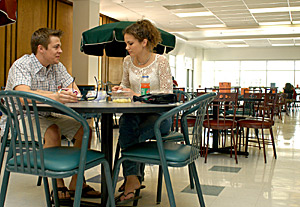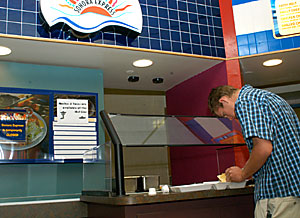 |
|
JACOB KONST/Arizona Daily Wildcat
|
Business freshman Danny Forman and Ashley Kolpack, an undeclared freshman, eat in a next-to-empty Park Student Union. Some businesses have been forced to close temporarily due to the poor turnout.
|
|
|
By Mitra Taj
Arizona Daily Wildcat
Tuesday, April 13, 2004
Print this
Union budget off by $3 million; jobs, hours cut
A year ago, student union administrators threw a weeklong celebration in honor of the grand opening of the Student Union Memorial Center.
The student union's tagline, "The biggest student union in the nation without a hotel attached," touted the grandeur of the recently completed $60 million renovation and expansion enterprise.
According to a newsletter for student union employees, student union administrators entered this fiscal year, which began July 2003, "with excitement and expectations that we were entering the best fiscal year in student union history."
But as Dan Adams, director of Arizona Student Unions, stated in the newsletter, "That was then and this is now."
The student union was expected to grow by $5 million this year, more than twice its growth since 2000.
Instead, student union businesses have missed the mark by about $3 million this year, shrinking the projected union budget by 14 percent.
"We're not hitting revenues across the board; that's everywhere, not just one area or another - everybody in every area," Adams said.
As a result, full-time employees have been laid off for the first time in seven years, and both unions are shortening their hours of operation.
Next semester, students will see prices in union restaurants and other retail operations rise by 5 percent.
Adams said what is happening is normal and no cause for serious concern.
"The union is doing fine; we're ahead of where we've been in past years," he said.
But while the student union budget has grown by about $2 million, those who envisioned a new student union are now re-evaluating their expectations and scaling back.
Union's growth was 'too big, too fast'
In the late 1990s, student union administrators hoped students would pay for half of the $60 million Student Union Memorial Center construction project through a $40 per semester fee.
But when students overwhelmingly voted down the proposal in a 1998 referendum, the student union, a nonprofit auxiliary that does not receive funding from the university, set out to fund the project on its own.
The construction that nearly doubled the original student union began in 2000 and was completed in February 2003.
Hopes were high as the student union opened last year with a weeklong celebration. But now, as reality dampens the expectations, some question whether the plans were too ambitious.
"We just got too big too fast," said Coleen Cummings, senior supervisor of dining services and manager of Louie's. "Business has gotten so bad that we're cutting down on full-time employees."
Dining services, made up of 13 student union-run restaurants and areas like catering and concessions, is expected to fall short by 15 percent of the $16.7 million that it was anticipated to make in revenue. Dining services typically make up at least 70 percent of the student unions' budget.
Four full-time student union employees were laid off last month, and 21 other student union positions lost this year have remained vacant.
Other cost-cutting methods have included shortening hours of operation and discontinuing breakfast in Cafˇ Sonora, Louie's and Chik-fil-A.
Louie's, a student union-run restaurant, is expected to underperform by $95,000, Adams said.
Louie's opened April 1, 2003, and might not be there come fall, said David Galbraith, director of dining services and associate director of Arizona Student Unions.
Pierce Simpson, a history junior, said he hasn't felt inspired to spend more time and money at the student union because it's become too big.
"In fact, I go there less. Most of it's a bunch of meeting rooms I've never seen used," he said. "The old union made you feel like you were more at home. It didn't feel like a mall food court."
Galbraith said the student union was built as much for the future as for this year.
"Right now, it may be a little too big. But over the next 50 years of its life, it will grow with the campus," he said. "In just three to five years, everything will have filled up, filled in, if nothing else, just due to inflation."
Adams said this year was bound to be an experimental year.
"It's the first year in four years that we've been fully operational," Adams said. "We'll make adjustments, we'll cut back. We're still figuring things out."
Student union officials also said bad timing and other unexpected factors have impeded the unions' ability to meet expectations.
"The timing of union construction happened at the same time as students and the university are in the toughest of economic times," Adams said.
Galbraith said much of dining services' shortcomings stem from unexpected jumps in labor costs, like the 30-cent minimum wage increase President Peter Likins approved for all university employees last semester. That increase came on top of additional benefits for employees approved by the Legislature a year and a half ago.
Likins said the minimum wage increase was necessary "to take care of the least paid people" on campus.
"We understand that when we do that, we do create financial pressures, but if I'm going to pay someone a living wage, I'm going to have to do that," he said.
Adams said in addition to wage increases, construction might also be hurting the student union financially.
Galbraith said construction pushed the opening of the Park Student Union back twice and is probably a major factor in why business has been slow this semester.
The student union food court is making 40 percent less than expected, and its under-performance as a whole will cost the unions about half a million, Galbraith said.
Sonora Express, a Mexican eatery in the Park Union, closed this semester as the poorest-performing restaurant in the food court.
Galbraith said the restaurant will reopen in the fall.
Though the student union food court was supposed to remain open year-round, it, and possibly all of the student union, will close over the summer, Adams said.
Galbraith said the Park Union will need to at least double its sales next semester in order to avoid further cost-cutting measures.
Prices increase; jobs, hours cut
Cummings, who has been working at the student union for 18 years, said she is upset to see employees lose their jobs and have their hours cut.
"It's depressing," she said. "I know these people, and change is hard. But I haven't been notified; I'm still working."
 |
|
KEVIN B. KLAUS/Arizona Daily Wildcat
|
Undeclared freshman Roman Black puts toppings on his hamburger yesterday in front of Sonora Express upstairs in the Park Student Union food court. Sonora Express closed after UA student unions lost more than $3 million in revenue. Many restaurants will implement a 5 percent increase in prices, and full-time employees are being laid off for the first time in seven years due to the poor income.
|
|
|
Last month, four full-time employees were laid off.
Galbraith said though he wishes he didn't have to let employees go, the layoffs were necessary.
All student union-run restaurants have cut employee hours, affecting over 100 workers, Galbraith said.
Aubrey McDonnell, a pre-education freshman who works at Louie's, said her 15- to 20-hour work week was cut down to about seven hours per week before spring break.
The student union offered her work in other businesses such as the Cellar, but she said she didn't want to work such late hours. She now works at Cactus Grill, where she said the "crazy hours" are hard to adjust to.
 |
We'll make adjustments, we'll cut back. We're still figuring things out.
- Dan Adams, director of Arizona Student Unions
|
 |
"It used to be that I would work right after classes, and then I'd go home and do homework. Now I have this big break in between," she said.
Panda Express, a private franchise that rents space in both student unions, has laid off six employees, said Kathy Kwok, general manager.
Li Tsou, area manager of operation, said the Chinese restaurant in the Park Student Union is making only 65 percent of what was originally expected.
"I was optimistic because the location looked good," he said.
Employees are not the only ones feeling the effects of the $3 million shortfall. Higher prices on particular items in some student union restaurants will amount to an average 5 percent price increase in those restaurants, Galbraith said.
Students who dine frequently in the student union said they're not looking forward to paying more for the same thing.
"It's already kind of expensive," said Samantha Willey, a sociology freshman. "And I've definitely been watching my budget lately."
Galbraith said not every restaurant will see prices rise, but those that have higher labor expenses, like Cactus Grill, 3 Cheeses & a Noodle and Cafe Sonora, will be targeted first.
Prices went up in the Wilbur's Underground Games Room in January, Adams said.
Galbraith said the price-hikes are a way of avoiding more layoffs.
The budget overestimation has also meant that student union-funded programs are seeing smaller portions of their budget come from the student union.
"If the union has a bad year financially, guess who gets affected?" said Terry Thompson, a senior leadership coordinator and director of Blue Chip, a leadership activity program of the Center for Student Involvement and Leadership.
Thompson said this school year has been trying for Blue Chip, which last semester started imposing a $100 fee on students who participate in the program.
Blue Chip now relies on the student union for about 25 percent of its funding, down from 50 percent last year. Thompson said he expects that in a few years, corporate sponsors will provide 60 percent of Blue Chip's funds and student fees will cover the remaining 40 percent.
Fiscal planning will help with future union growth
Student union officials are projecting a budget of about $900,000 less than what they expected to reach this year.
Although Galbraith said the student union's financial situation will improve as it "grows into itself," he said he is concerned about what will happen in 50 years when the student union is due for another renovation.
He said the student union should put away about $100,000 into reserves for future building projects.
"That's really good planning, very professional and responsible planning," Galbraith said.
But because of this year's shortfall, the student union hasn't been able to start saving for the future.
"It's how we got into this situation in the first place," Galbraith said. "Nobody was planning for the future, and suddenly we had to rebuild."

